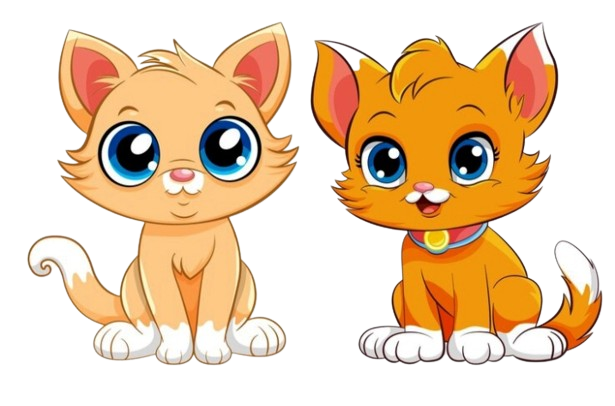Japanese bobtail
The Japanese Bobtail is a very ancient breed dating back at least 1000 years. According to legend, these cats were brought from China as a gift from the Chinese emperor to the Japanese.
Another story says that the Japanese Bobtail cat has been a companion of Korean and Chinese traders since the 6th century, guarding the contents of the holds (especially silkworms) against rats. Thus, over time, Japanese traders also appreciated these animals, and later rumors reached the emperor.
In fact, both legends do not contradict each other and can exist simultaneously. Japanese legends and folklore in general contain a lot of references to short-tailed cats, and tricolor bobtails are depicted on engravings of the Edo period (1603-1867).
For many centuries, the Japanese Bobtail cat breed was the exclusive domain of the imperial family and high-ranking officials. However, in the 15th century, there was an urgent need to protect the warehouses of grain and silkworms from rodents. After all, with the growth of the industry and the increase in the population, the number of rodents grew exponentially.
The emperor issued a special decree in which" bare mortals" were also allowed to have these pussycats. Consequently, they began to perform an important function, guarding the storages of grain and the most precious silkworms from rodents. A black-red color on a white background was considered a symbol of good luck- they were called “ Mi- Ke ”, which means “ Three Furs ”. In Japan, this is still a true moment.
Three individuals were brought to the United States in 1968, and by 1976 the shorthair variety was recognized by the Association of Cat Fanciers. But the long-haired Japanese Bobtail received CFA recognition only in 1993.
Characteristics of the breed
Adaptability 10/10
Attachment to family 10/10
Game activity 10/10
Intelligence 10/10
General Health 09/10
Hair loss 01/10
Child-friendly 08/10
Dog friendly 10/10
Love of Meows 10/10
Information about the breed
|
Country of origin |
Japan |
|
Lifespan |
14-16 years old |
|
Size |
medium |
|
Weight |
Cats: 3.5-5.5 kg, Cats: 2.5-3.5 kg |
|
wool type |
shorthair |
|
Color |
all coat colors and patterns except chocolate, lilac,
colorpoint, and ticked tabby |
|
Lifestyle |
in room |
|
Price |
600 - 1000$ |
Description
The Japanese Bobtail is a loving, incredibly loyal cat that
thrives in a family. They are very active, and playful, feel great with
children, and get along well with other pets, although it is necessary to
gradually accustomed to the presence of a second pet in the house. However,
one must be careful here - the hunter's instinct developed over hundreds of
years can encourage them to hunt for fish or hamsters.
The Japanese Bobtail breed arose through natural evolution and is one of the oldest. They have muscular bodies, climb trees
perfectly, and are practically not afraid of water. The front and hind legs
are approximately the same lengths, the ears are medium, and the head is
proportional, and wedge-shaped. The tail is short, on average 5-7 cm. These
cats are distinguished by grace and harmony, despite their muscular body and long
legs, they do not look massive.
Personality
The Japanese Bobtail cat breed is playful and
friendly. These pets show their love and affection to each member of their
family, because historically, they lived together with people for many hundreds
of years, enjoying respect and kindness. We can say that they have a
harmonious relationship with people genetically, which is why they are very
attached to their family and will be really sad if you go on vacation and do
not take your pet with you.
The sharp and flexible mind of Japanese Bobtails can sometimes
surprise you unexpectedly - they easily open doors, turn door handles and even
latches, and sometimes it’s not even entirely clear how. Their playful
disposition and great love towards their family are manifested in literally
everything, including their “talkativeness”. Also, they love children and
are happy to play with them, but care must be taken that children do not twist
their tails and do not squeeze the animal too much.
These cats do not really like to be alone, and if one of the
owners is at home, with a probability of 99%, the bobtail will spend time with
a person. On the other hand, when you leave for work, the cat will not be
inconvenienced, as he knows that you will return.
They remember sometimes insignificant, seemingly everyday
moments. For example, it is worth feeding a cat at night and he will wake
you up for this all the time. Therefore, one must be careful with what to
teach the Japanese Bobtail. Also, they have a deep instinct to a hunter,
because for hundreds of years, they hunted rodents to help people.
Common diseases
Japanese Bobtails are generally healthy, and the recessive
gene for a short tail is not associated with any spinal or bone abnormalities,
unlike some other breeds with irregular body builds.
Care
The Japanese Bobtail does not have a thick undercoat, and
this applies to both long-haired and short-haired
individuals. Accordingly, weekly combing is enough to remove dead
hair. The wool of these animals in its structure is not inclined to form
lumps, which simplifies care. Be aware that both longhaired and
shorthaired bobtails shed.
Brushing your teeth should be done three times a week, preferably every day. Ears should be cleaned at least once a week, and the
litter box should be kept clean. The coat of these cats is resistant to
getting wet, so bathing once every two weeks is enough.


.jpg)
.jpg)
.jpg)
